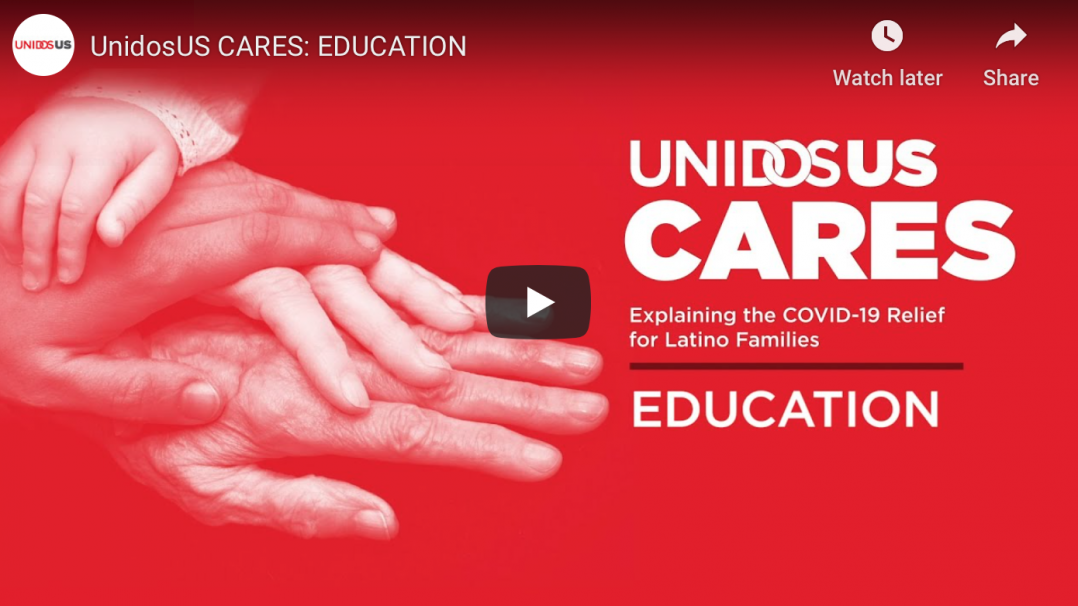Multimedia Report:
How the CARES Act Impacts Students, Educators, and Families During and After the Coronavirus Pandemic
Video Featuring Tania Valencia and Produced by Elnatan Melaku Mulugeta. Text by Julienne Gage.
Whether you’re a parent struggling to find child care while working on the front lines of the COVID-19 pandemic, a K-12 teacher struggling to keep your students on track for graduation, or a college student wondering how you’ll ever get through school, join the job market, and pay down your debt in the crisis-ridden economy the Coronavirus has created, ProgressReport.co is working with its UnidosUS education policy team to keep you informed and help you navigate this unprecedented time.
Over the past several weeks, the policy team has been reviewing and weighing in on the various pieces of Coronavirus relief bills. Following the recent passing of the $2.2 trillion package—the Coronavirus Aid, Relief, and Economic Security Act or CARES Act—the team created a policy brief and worked with ProgressReport.co to build a corresponding explainer video aimed at highlighting the bill’s impact on education. That information is reflected in this post, along with further comments from the education policy team.
“This is the biggest relief so far for students and their families yet there’s so much more to be done to ensure students continue their education.” UnidosUS Associate Director of Education Policy Amalia Chamorro tells ProgressReport.co.
Early Childhood Education
Children’s most rapid physical, emotional, and cognitive growth is fastest in the first few years of life, but most child care centers are temporarily closed for the safety of the kids and the workers. The CARES Act has a supplemental $3.5 billion for the Child Care and Community Development Block grant to keep child care workers on the payroll and help centers reopen when the pandemic passes, and to subsidize emergency staffing and care for the children of first responders, regardless of their income.
The act also allocates $750 million to Head Start, the nation’s largest early learning and child care program for low-income families, to provide for similar emergency care and ease service interruptions.
UnidosUS believes these funds should have a significant impact on the U.S. Latino population. US Census data shows that Hispanic families represent 18.3% of the poverty rate. Plus, 37% of Head Start enrollees are Latino, and that number jumps to 94% of its offshoot program Migrant and Seasonal Head Start, which services the children of farmworkers.
“From food production and distribution to janitorial services and health care supports, many Latino families are working on the frontlines of the crisis. They can’t do this work and ensure healthy outcomes for their own children without having access to child care,” says Chamorro, noting that some Head Start programs have had to close temporarily, including members of the UnidosUS Affiliate Network like East Coast Migrant Head Start.
“We must also ensure childcare centers that have closed are able to survive and reopen when parents return to work,” she adds.
K-12 Education
Since the crisis began, some 124,000 public schools have closed, leaving 55.1 million students across the country attempting to home school and learn online or left out of the education system entirely. Those numbers are alarming by any measure, but they are particularly concerning to UnidosUS since one in four of those students is Latino, and five million of them are English learners (ELs).
The CARES Act is trying to address this crisis by providing $13.5 billion through an education stabilization fund to offset costs of closures, provide new online learning technology, offer mental health services and supports, and build out summer and afterschool programs to fit the circumstances. And since it’s difficult for the federal government to perceive all of the emerging educational crises, it is allocating another $3 billion for state governors to use as they see fit for the most impacted educational agencies in their states.
But UnidosUS is concerned about how the act’s efforts to create a flexible educational program could exacerbate already existing opportunity gaps for vulnerable student populations.
Under the Every Student Succeeds Act, the latest legislation of decades-old federal laws regarding equal access to public education, schools must document the progress of vulnerable students and provide added supports as needed. That population includes students of color, ELs, students with disabilities, and those who are low-income. However, under the CARES Act, the Department of Education has the authority to temporarily waive accountability requirements for school and student achievement.
“Of course we know it’s too hard to maintain standardized testing during the crisis, but we want to make sure that assessment flexibility really is a one-time thing. Otherwise the opportunity gaps we saw prior to the pandemic could be exacerbated,” says UnidosUS Education Policy Analyst Tania Valencia.
Higher Education
Over the past few decades, Latino enrollment in colleges and universities has skyrocketed. Between 1990 and 2016, Hispanic enrollment in postsecondary programs increased 337%–from 782,400 to 3.4 million students. But even before the pandemic, they faced several economic and logistic hurdles to stay enrolled and graduate within six years.
With this in mind, UnidosUS’s education policy team was actively pushing for a reduction of up to $10,000 on college loans during some of the first coronavirus response proposals. That effort did not come to fruition in the CARES Act, but there are some significant signs of relief.
The act creates a $14 billion higher-education stabilization fund, and at least half of it will go toward the costs of emergency tuition, course materials, food, housing, health and childcare. Another $1 billion of those funds are earmarked for minority-serving institutions, and the rest will help colleges and universities get their instruction online.
Between now and September 30, 2020, the act authorizes the Department of Education to automatically suspend payments and stop interest on certain federal loans. Borrower’s credit scores will not be affected by this pause, and nor will they be susceptible to involuntary collections on any federal funds. Finally, there shall be no interruption to TEACH grants for future teachers or to the Public Service Loan Forgiveness.
“For most Latinos, completing a postsecondary degree is their surest pathway to social and economic mobility. COVID-19 diminishes these benefits without key long-term investments funneled into our nation’s postsecondary system,” says Amanda Martinez. “The CARES Act emergency aid was significant, especially for Latino students who are more likely to be Pell eligible and attend Hispanic–Serving Institutions. However, this was a short-sighted proposal that did not include any long-term solutions to prevent the widening Latino college completion gap.”
Next Steps
The UnidosUS policy team says it will continue to monitor the rollout of the CARES Act and work to ensure that it is one of several packages aimed at bringing relief to the nation’s most vulnerable families and students during the pandemic, and for its part, ProgressReport.co will continue to post policy updates and analysis, as well as share ideas for distance learning.
“Now that Congress has acted to provide much needed aid to schools, districts, and institutions of higher education, we will continue to be vigilant on implementation, as it’s critical that students with the highest need—students with disabilities, ELs, among others—receive the aid and services they need so achievement gaps are not further exacerbated during this time,” says UnidosUS Education Policy Advisor Roxanne Garza.


